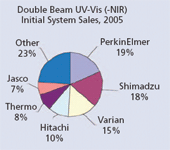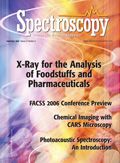Market Profile: Double-Beam UV-Vis Spectrophotometers
Double-beam UV–Vis spectrophotometers include the most advanced instruments in the UV–Vis market today. They allow more rapid and greatly simplified UV–Vis analyses for users. The market for double-beam UV–Vis instruments is dominated by the major diversified scientific instrument manufacturers.
Double-beam UV–Vis spectrophotometers include the most advanced instruments in the UV–Vis market today. They allow more rapid and greatly simplified UV–Vis analyses for users. The market for double-beam UV–Vis instruments is dominated by the major diversified scientific instrument manufacturers.

In older single-beam spectrophotometers, a reference blank must first be inserted for the instrument to establish a P0 value with which to compare the sample spectrum. In double-beam systems, the light is typically split or alternatively directed in two directions after it has passed through the monochromator, with one path directed through the sample and the other through the reference blank. This eliminates the need to manually switch cuvettes between zeroing the instrument and running the sample, and reduces the total analysis time, as well as eliminating the possibility of lamp drift and other slow fluctuations affecting the measurement. For the most part, all double-beam UV–Vis instruments are scanning systems, which are relatively slow, but many are now capable of performing faster fixed wavelength measurements as well.
The combined worldwide market for laboratory double-beam UV–Vis and UV–Vis-NIR initial systems in 2005 was nearly $180 million, which represented well over a third of UV–Vis-NIR initial system sales. The majority of scanning UV–Vis system sales and nearly all UV–Vis-NIR system sales by the major vendors are of the double-beam configuration. Demand for dual-beam UV–Vis instruments should see consistently moderate single digit growth for the foreseeable future.
The foregoing data were extracted from SDi's market analysis and perspectives report entitled Edition Global Assessment Report, 9th Edition: The Laboratory Life Science and Analytical Instrument Industry, August 2006. For more information, contact Stuart Press, Senior Consultant, Strategic Directions International, Inc., 6242 Westchester Parkway, Suite 100, Los Angeles, CA 90045, (310) 641-4982, fax: (310) 641-8851, www.strategic-directions.com.

Market Profile: Mass, Molecular, and Atomic Spectroscopy
December 1st 2018Mass spectrometry, molecular and atomic spectroscopy technologies combine to represent more than a fifth of the overall market for laboratory analytical instrumentation. These techniques are perhaps the most broadly used instruments, with utility in pharmaceuticals and other life sciences, chemicals, environmental, food, clinical/Dx and other applications.